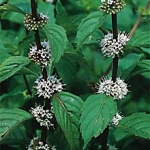| Common Name: | Peppermint |
Other Names: | Brandy Mint, Curled Mint, Lamb Mint |
Botanical Name: | Mentha x piperita syn. M. nigricans |
Genus: | Mentha |
| Family: | Lamiaceae |
| Cultivation: | Rich, moist soil in sun or partial shade. Mentha aquatica thrives in wet soil and M. arvensis tolerates dry conditions. Mentha pulegium prefers damn, sandy, acid soil; M. requienii needs moist shady conditions. Foliage may damaged by mildew and rust, though M. x villosa var. alopecuroides is resistant to rust. Most mints are invasive and are best grown in confined space. Mentha pulegium is a protected species in parts of Europe, and subject to statuatory control as a weed in some countries, notably in parts of Australia. |
| Propagation: | By seed sown in spring (M. pulegium, M. requienii, M. satureioides only); by division in spring or autumn; by tip cuttings during the growing season, placed in moist soil mix or water (not M. requienii). Mentha requienii usually self sown self-sows. |
| Harvest: | Whole plants are cut as flowering begins, and leaves are cut during the growing season, and used fresh or dried for use in concentrated waters, infusions, liquid extracts, powders, spirits, or oil distillation. Mentha arvensis is mainly decocted or powdered in Chinese remedies. |
| Height: | 30-90cm (12-36in) |
:Width | Indefinite |
| Variations: |
f. citrata ‘Basil’
Has a distictive basil aroma. | f. citrata ‘Chocolate’
Has a chocolate-peppermint scent | f. citrata syn. ‘Citrata’
(Eau de cologne mint, bergamot mint)
Has ovate, bronze-purple leaves and a lavender-like aroma. |
f. citrata ‘Lavender’
Has gray-green leaves with purple undersides; Dried leaves are distinctly lavender scented. | f. citrata ‘Lemon” syn. ‘Lemon Bergamot
(Lemon Mint)
Has light green, lemon-scented leaves and pink flowers. | f. citrata ‘Lime’
Has rounded, dark green leaves with a lime-like aroma. |
f. citrata ‘Orange’ syn. ‘Orange Bergamot’
Has purple-edged dark green leaves with a strong citrus-like scent; good for tea. | ‘Swiss Ricola’ syn. ‘Swiss’
Has a light refreshing peppermint flavor; extracts used in Swiss herbal candy. | ‘Variegata’
Has dark green leaves with irregular cream variegation. |
|
| Hardiness: | Z4-9 |
| History: | Long prized for its refreshing taste and pleasantly sharp aroma, peppermint has been hailed for its superb culinary and medicinal uses since ancient Greek, Egyptian, and Roman times. In fact, the Greeks not only used mint, they immortalized it in one of their classic tales of the ever feuding gods and goddesses of Greek mythology. As the myth has it, Pluto, the Greek god of the Underworld, fell passionately in love with Minthe, a water nymph and daughter of the river god Cocyte. Pluto’s wife Proserpina, became so jealous of Minthe that she turned her into the mint plant. But Minthe had her day, too. As “progenitor” of the mint family—botanically known as the Labiatae family—she mothered more than 600 species and hybrids of mint. Peppermint is among the most famous. |
| Parts Used: | Whole plant, leaves, oil. |
| Properties: | A decongestant, strongly aromatic, bitter herb. Relieves spasms, increases perspiration, improves digestion, and had antiseptic, mildly anesthetic effects; acts mainly on the digestive system, especially on the lower bowel. |
Vitamin Content: | Vitamin A, Thiamin |
| Medicinal Uses: | Internally (M. x piperita) for nausea, morning sickness, indigestion, gastric ulcer, gastroenteritis, irritable bowel syndrome, colic, influenza (especially in the feverish stage), and colds. Externally for upper respiratory tract infections, sinusitis, mucus, asthma, itching skin conditions, burns, ringworm, neuralgia, rheumatism, and as an insect repellent. Excessive use of the oil causes irritation to the mucous membranes. May cause allergic reaction. Not given to infants in any form. Mentha x piperita f. citrata has uses (such as for infertility, nervous exhaustion, and rapid heartbeat) more akin to Lavandula angustifolia (See, lavender) than to peppermint.
Peppermint tea, made from the plant’s leaves, is taken internally for a wide variety of ailments: stomach cramps, stomach pain, colic, flatulence, nausea, motion sickness, morning sickness, irritable bowel syndrome (IBS), fever, colds, and flu. It is probably most famed as a digestive aid. Menthol, peppermint’s primary ingredient, speeds digestion by stimulating the stomach lining. Food then moves more quickly out of the stomach, and indigestion is less likely to occur. Peppermint also relaxes digestive and stomach muscles. Externally, peppermint oil is used for respiratory ailments, coughs, sinus congestion, some skin conditions, and rheumatism. |
| Preparation: | To brew homemade peppermint tea, pour 1 cup of boiling water over 1 to 2 heaping teaspoons of dried herb and steep for 10 minutes. Drink up to 3 cups a day. |
| Culinary Uses: | Leaves (M. x piperita) are used in teas, iced drinks, and salads. |
| Economic Uses: | Oil (M x piperita, M. x piperita f. citrata) is used in oral hygiene preparations, colds and influenza remedies, antacids, and toiletries; also in perfumery, and to flavor medicines, cigarettes, candy, ice cream, and liqueurs, including crème de menthe. M. x piperita f. citrata is a source of lavender oil for perfumery. Leaves are added to potpourris. |
Caution: | Never ingest pure peppermint oil; it is quite toxic. Very young children and pregnant women should only use a diluted form of peppermint tea. Pregnant women with a history of miscarriage should not use peppermint. |
| Bibliography: | Encylopedia of Herbs by Deni Brown Copyright ©: 1995, 2001 Dorling Kindersley Limited pp.275-277
The Modern Herbal Primer by Nancy Burke Copyright©2000 Yankee Publishing, Inc. pp. 88-89 |

